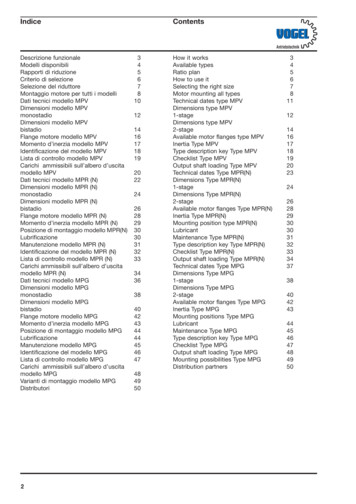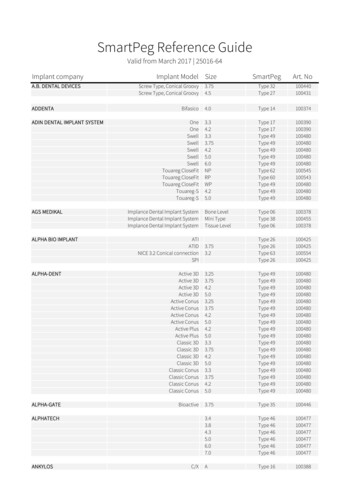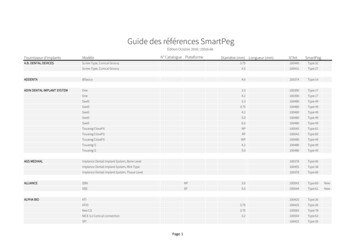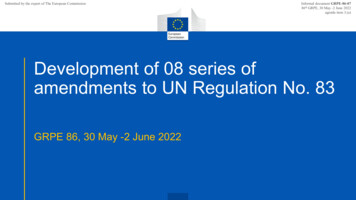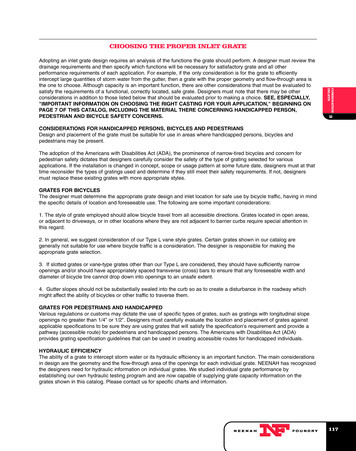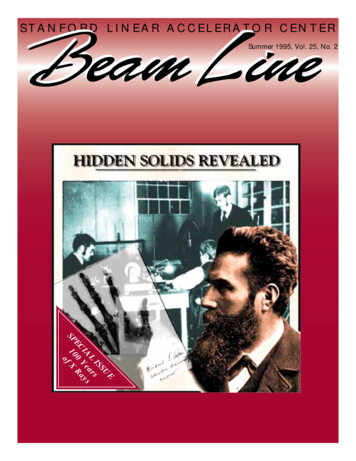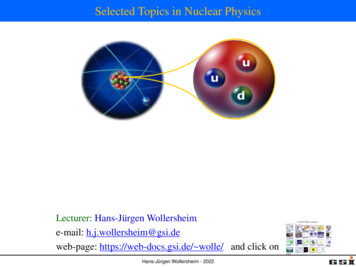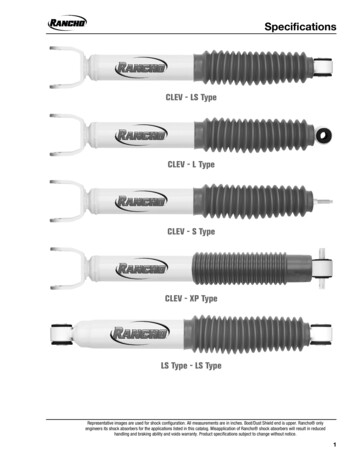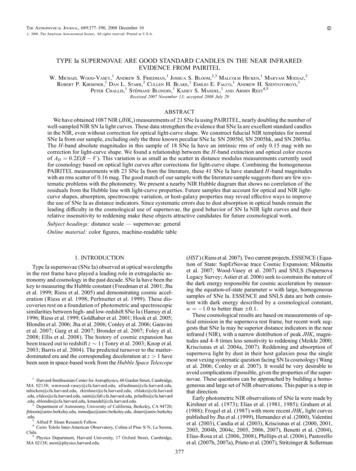
Transcription
The Astrophysical Journal, 689:377Y390, 2008 December 10A# 2008. The American Astronomical Society. All rights reserved. Printed in U.S.A.TYPE Ia SUPERNOVAE ARE GOOD STANDARD CANDLES IN THE NEAR INFRARED:EVIDENCE FROM PAIRITELW. Michael Wood-Vasey,1 Andrew S. Friedman,1 Joshua S. Bloom,2,3 Malcolm Hicken,1 Maryam Modjaz,2Robert P. Kirshner,1 Dan L. Starr,2 Cullen H. Blake,1 Emilio E. Falco,1 Andrew H. Szentgyorgyi,1Peter Challis,1 Stéphane Blondin,1 Kaisey S. Mandel,1 and Armin Rest4,5Received 2007 November 13; accepted 2008 July 29ABSTRACTWe have obtained 1087 NIR (JHKs ) measurements of 21 SNe Ia using PAIRITEL, nearly doubling the number ofwell-sampled NIR SN Ia light curves. These data strengthen the evidence that SNe Ia are excellent standard candlesin the NIR, even without correction for optical light-curve shape. We construct fiducial NIR templates for normalSNe Ia from our sample, excluding only the three known peculiar SNe Ia: SN 2005bl, SN 2005hk, and SN 2005ke.The H-band absolute magnitudes in this sample of 18 SNe Ia have an intrinsic rms of only 0.15 mag with nocorrection for light-curve shape. We found a relationship between the H-band extinction and optical color excessof AH ¼ 0:2E(B " V ). This variation is as small as the scatter in distance modulus measurements currently usedfor cosmology based on optical light curves after corrections for light-curve shape. Combining the homogeneousPAIRITEL measurements with 23 SNe Ia from the literature, these 41 SNe Ia have standard H-band magnitudeswith an rms scatter of 0.16 mag. The good match of our sample with the literature sample suggests there are few systematic problems with the photometry. We present a nearby NIR Hubble diagram that shows no correlation of theresiduals from the Hubble line with light-curve properties. Future samples that account for optical and NIR lightcurve shapes, absorption, spectroscopic variation, or host-galaxy properties may reveal effective ways to improvethe use of SNe Ia as distance indicators. Since systematic errors due to dust absorption in optical bands remain theleading difficulty in the cosmological use of supernovae, the good behavior of SN Ia NIR light curves and theirrelative insensitivity to reddening make these objects attractive candidates for future cosmological work.Subject headinggs: distance scale — supernovae: generalOnline material: color figures, machine-readable table1. INTRODUCTION(HST ) (Riess et al. 2007). Two current projects, ESSENCE (Equation of State: SupErNovae trace Cosmic Expansion; Miknaitiset al. 2007; Wood-Vasey et al. 2007) and SNLS (SupernovaLegacy Survey; Astier et al. 2006) seek to constrain the nature ofthe dark energy responsible for cosmic acceleration by measuring the equation-of-state parameter w with large, homogeneoussamples of SNe Ia. ESSENCE and SNLS data are both consistent with dark energy described by a cosmological constant,w ¼ "1:0 to better than 0.1.These cosmological results are based on measurements of optical emission in the supernova rest frame, but recent work suggests that SNe Ia may be superior distance indicators in the nearinfrared ( NIR), with a narrow distribution of peak JHKs magnitudes and 4Y8 times less sensitivity to reddening (Meikle 2000;Krisciunas et al. 2004a, 2007). Reddening and absorption ofsupernova light by dust in their host galaxies pose the singlemost vexing systematic question facing SN Ia cosmology (Wanget al. 2006; Conley et al. 2007). It would be very desirable toavoid complications if possible, given the properties of the supernovae. These questions can be approached by building a homogeneous and large set of NIR observations. This paper is a step inthat direction.Early photometric NIR observations of SNe Ia were made byKirshner et al. (1973); Elias et al. (1981, 1985); Graham et al.(1988); Frogel et al. (1987) with more recent JHKs light curvespublished by Jha et al. (1999), Hernandez et al. (2000), Valentiniet al. (2003), Candia et al. (2003), Krisciunas et al. (2000, 2001,2003, 2004b, 2004c, 2005, 2006, 2007), Benetti et al. (2004),Elias-Rosa et al. (2006, 2008), Phillips et al. (2006), Pastorelloet al. (2007b, 2007a), Prieto et al. (2007), Stritzinger & SollermanType Ia supernovae (SNe Ia) observed at optical wavelengthsin the rest frame have played a leading role in extragalactic astronomy and cosmology in the past decade. SNe Ia have been thekey to measuring the Hubble constant (Freedman et al. 2001; Jhaet al. 1999; Riess et al. 2005) and demonstrating cosmic acceleration ( Riess et al. 1998; Perlmutter et al. 1999). These discoveries rest on a foundation of photometric and spectroscopicsimilarities between high- and low-redshift SNe Ia (Hamuy et al.1996; Riess et al. 1999; Goldhaber et al. 2001; Hook et al. 2005;Blondin et al. 2006; Jha et al. 2006; Conley et al. 2006; Garaviniet al. 2007; Garg et al. 2007; Bronder et al. 2007; Foley et al.2008; Ellis et al. 2008). The history of cosmic expansion hasbeen traced out to redshift z # 1 ( Tonry et al. 2003; Knop et al.2003; Barris et al. 2004). The predicted turnover to the matterdominated era and the corresponding deceleration at z 1 havebeen seen in space-based work from the Hubble Space Telescope1Harvard-Smithsonian Center for Astrophysics, 60 Garden Street, Cambridge,MA 02138; wmwood-vasey@cfa.harvard.edu, afriedman@cfa.harvard.edu,mhicken@cfa.harvard.edu, rkirshner@cfa.harvard.edu, cblake@cfa.harvard.edu, efalco@cfa.harvard.edu, saint@cfa0.cfa.harvard.edu, pchallis@cfa.harvard.edu, sblondin@cfa.harvard.edu, kmandel@cfa.harvard.edu.2Department of Astronomy, University of California, Berkeley, CA 94720;jbloom@astro.berkeley.edu, mmodjaz@astro.berkeley.edu, dstarr@astro.berkeley.edu.3Alfred P. Sloan Research Fellow.4Cerro Tololo Inter-American Observatory, Colina el Pino S/ N, La Serena,Chile.5Physics Department, Harvard University, 17 Oxford Street, Cambridge,MA 02138; arest@physics.harvard.edu.377
378WOOD-VASEY ET AL.(2007), Wang et al. (2008), Pignata et al. (2008), and Taubenbergeret al. (2008). Northern hemisphere work from the Center for Astrophysics (CfA) Supernova Program uses observations fromthe robotic 1.3 m Peters Automated Infrared Imaging Telescope( PAIRITEL; Bloom et al. 2006b) at Mount Hopkins, Arizona.The NIR observations are part of a systematic program of supernova observations that includes dense sampling of supernovaspectra ( Matheson et al. 2008) and concurrent UBVri opticalphotometry (M. Hicken et al. 2008, in preparation). This paper isa first report on the NIR data on SNe Ia from PAIRITEL. Similarwork is underway in the southern hemisphere by the CarnegieSupernova Project using observations at the Las CampanasObservatory in Chile (Freedman 2005; Hamuy et al. 2006). Theprospect of large homogeneous data sets coupled with progressin modeling SN Ia NIR light curves (Kasen 2006) raises hopesthat SNe Ia, especially in the rest-frame H band, can be developed into the most precise and accurate of cosmological distanceprobes.Recent work by Krisciunas et al. (2004a) shows that SNe Iahave a narrow range of luminosity in JHKs at the time of B-bandmaximum light (tBmax ) with smaller scatter than in the B andV bands. Krisciunas et al. (2004a) found no correlation betweenoptical light-curve shape and intrinsic NIR luminosity. The NIRbehavior is in sharp contrast with the optical light curves, where avariety of ingenious methods have been devised to reduce thescatter in distance estimates: the !m15 method ( Hamuy et al.1996; Phillips et al. 1999; Prieto et al. 2006), the multicolor lightcurve shape method (MLCS/ MLCS2k2; Riess et al. 1996, 1998;Jha et al. 2007), the ‘‘stretch’’ method ( Perlmutter et al. 1997;Goldhaber et al. 2001), the color-magnitude intercept calibrationmethod (CMAGIC; Wang et al. 2003), the spectral adaptive template method (SALT/SALT2; Guy et al. 2005, 2007; Astier et al.2006), and SiFTO (Conley et al. 2008). For a sample of 16 SNe Iaobserved in NIR bands, Krisciunas et al. (2004a) found an rms of!J ¼ 0:14, !H ¼ 0:18, and !Ks ¼ 0:12 mag. We set out to construct an independent set of observations to test this remarkableresult.In this paper we present 21 SNe Ia observed with PAIRITELfrom 2005 to 2007. The 1087 individual data points in this sample represent the largest homogeneous set of SNe Ia to date anddouble the number of NIR SN Ia observations in the literature.Data collection with PAIRITEL is discussed in x 2. Data analysis, including the mosaic creation process and our photometrypipeline, is discussed in x 3. We construct NIR JHKs templatesfrom this new sample as detailed in x 4 and fit these templates tothe SN Ia light curves to derive the JHKs magnitudes at the timeof B-band maximum light. These magnitudes are remarkably uniform, particularly in the J and H bands. Distances are calculatedin x 5, and we discuss the standard magnitude of NIR SNe Ia inx 6. We then compare our sample to that compiled in Krisciunaset al. (2004a) as well as to some more recent SNe Ia ( Krisciunaset al. 2005, 2006, 2007; Phillips et al. 2006; Pastorello et al.2007a; Stritzinger & Sollerman 2007; Wang et al. 2008; EliasRosa et al. 2006, 2008; Pignata et al. 2008; Taubenberger et al.2008) in x 7 and show that the J and H bands at maximum light,even from this heterogeneous sample, have a small range in absolute magnitude. Our conclusions are summarized in x 8.2. DATAWe present 1087 near-infrared ( NIR) measurements with asignal-to-noise ratio (S/ N ) 3 of 21 nearby SNe Ia obtainedfrom 2005 to 2007 using the f/13.5 1.3 m PAIRITEL at the F. L.Whipple Observatory on Mount Hopkins in Arizona ( Table 1).Vol. 689Dedicated in 2004 October, PAIRITEL uses the northern telescope of the Two Micron All Sky Survey (2MASS; Skrutskie et al.2006) together with the 2MASS southern camera. PAIRITEL isa fully automated, robotic telescope with the sequence of observations controlled by an intelligent queue-scheduling database ( Bloom et al. 2006b). Two dichroics allow simultaneousobserving in JHKs (1.2, 1.6, and 2.2 "m; Cohen et al. 2003)with three 256 ; 256 pixel HgCdTe NICMOS3 arrays. The image scale of 2 00 pixel"1 provides a field of view of 8:53 0 ; 8:53 0for each filter. Since the supernova observations are conductedwith the instrument that defines the 2MASS photometric system,we use the 2MASS point source catalog (Cutri et al. 2003) toestablish the photometric zero points. Images are obtained withstandard double-correlated reads with the long (7.8 s) minusshort (51 ms) frames in each filter treated as the ‘‘raw’’ frame inthe reduction pipeline. The telescope is dithered ( 2 0 ) everyfourth exposure to aid with reductions.The CfA Supernova Program used PAIRITEL to follow upSNe discovered by optical searches at # k "30% with V P 18mag. These are objects for which we routinely obtain extensivedata sets of optical spectra and CCD photometry using otherinstruments at Mount Hopkins. With #30% of the time on thisdedicated robotic telescope available for supernova observations, we observe approximately three to five SNe per night andobtain host galaxy template reference images for each supernova. The first published PAIRITEL supernova observationswere of the unusual core-collapse SN 2005bf ( Tominaga et al.2005). There have been previous papers that present the dataprocessing from PAIRITEL ( Bloom et al. 2006a, 2007; Butleret al. 2006; Yost et al. 2006; Blake et al. 2007; Eisner et al.2007; Modjaz et al. 2008), but since NIR photometry remainsmore challenging than optical photometry we present a briefsketch of the data analysis path in the next section.3. DATA ANALYSISData were processed with one of two mosaicking pipelines.For fields dominated by large galaxies we used a pipeline (seeModjaz 2007; Kocevski et al. 2007) that makes use of a bank ofexisting sky frames. For all other fields, we used the standardpipeline (see x 3.1). Both pipelines process the 100Y150 images,each of 7.8 s duration, by flat correction, dark and sky subtraction, registration, and stacking to create a final mosaicked imagein each of the JHKs filters. Mosaicked images typically comprisethree images at each dither position, with a mosaicked field ofview (FOV) of #12 0 ; 12 0 . The raw images are SWarped (Bertin2005) using 0:1 00 pixel"1 subsampling into final mosaics with1 00 pixel"1 sampling. Typical 1800 s observations (includingslew overhead) reach magnitude limits of #18, 17.5, and 17 magfor J, H, and Ks , respectively.3.1. MosaicsThe PAIRITEL camera has no shutter, so dark current cannotbe measured independently, and ‘‘skark’’ background frames include both sky and dark photons. PAIRITEL supernova observations did not include pointings that alternate between the sourceand the sky, so skark frames were created for each mosaic.For large host galaxies with angular size k2 0 (in the 12 0 FOV),host galaxy contamination prevents a reliable calculation ofthe skark background calculated from a pixel-by-pixel medianthrough the stack of dithered images. Here skark frames are estimated using a median match to an archive of skark frames inrelatively empty fields observed on the same night. The archival skark image is selected as close in time to the supernova
No. 1, 2008SNe Ia AS NIR STANDARD CANDLES FROM PAIRITEL379TABLE 1SN Ia JHKs Peak 1998bu .1999cl .1999cp .1999ee.1999ek .1999gp .2000E.2000bh .2000bk .2000ca.2000ce.2001ba .2001bt .2001cn .2001cz.2001el .2002bo .2002cv .2002dj .2003du .2003cg .2004S.2004eo .2005ao .2005blc .2005cf .2005ch .2005el .2005eq .2005eu .2005hkc .2005iq .2005kec .2005na .2006D .2006N .2006X .2006ac.2006ax .2006cp .2006gr.2006le .2006lf.2007cq 7717.0217.8416.1515.5916.37 140.050.040.070.100.080.05Hpeaka11.59 12.77 14.77 15.00 16.08 17.16 13.74 16.75 17.45 16.71 16.12 17.24 15.64 15.66 15.65 12.97 13.82 14.34 14.79 14.66 13.68 15.04 15.79 17.65 17.33 13.96 16.99 15.55 17.05 17.20 15.60 17.61 13.98 16.96 14.47 15.90 12.92 16.60 16.11 16.96 17.82 16.38 15.50 16.92 0.020.200.100.150.180.050.130.2111.42 12.58 14.57 .16.54 16.51 13.42 16.64 .15.98 17.06 15.40 15.67 15.40 12.84 13.88 13.95 14.50 14.38 13.43 14.87 15.67 16.82 17.47 13.97 16.20 15.31 16.51 16.64 15.48 .14.03 16.76 14.54 15.72 12.74 16.44 15.89 16.84 17.72 16.05 15.24 .170.14NJ, NH, NKbReferences18, 20, 206, 5, 62, 2, 233, 33, 014, 15, 13, 3, 316, 15, 1020, 21, 1518, 16, 012, 11, 03, 5, 515, 14, 921, 21, 1119, 19, 312, 12, 933, 32, 3214, 14, 1417, 10, 1621, 21, 216, 6, 610, 10, 1016, 17, 1211, 9, 106, 6, 515, 12, 417, 17, 1510, 10, 829, 29, 2930, 26, 2722, 22, 1818, 12, 1310, 3, 019, 18, 1024, 19, 722, 22, 2014, 12, 1160, 66, 4720, 22, 1517, 16, 165, 5, 36, 4, 138, 32, 3630, 33, 265, 4, 02, 344891668168168999795, 121514111013117, 11d11111111111d1111111aMagnitudes of the maximum observed magnitude in JHKs . Magnitude errors are 1 ! symmetric errors.Number of epochs with S/N 3 in the JHKs light curves, respectively.cThe fast-declining, unusual SN 2005bl, SN 2005hk, and SN 2005ke were excluded from the template generation. When fitwith the H-band template they are clearly rejected as outliers with 2 /dof 3. See Fig. 3 for a visual comparison of the H-bandlight curves of these dromedary SNe Ia compared with the H-band template.dBecause we had data from PAIRITEL on these SNe Ia we did not take advantage of the photometry of SN 2005cf providedin Pastorello et al. (2007b) or that of SN 2006X provided in Wang et al. (2008).References.—(1) PAIRITEL photometry; this paper; (2) Jha et al. 1999; (3) Hernandez et al. 2000; (4) Krisciunas et al.2000; (5) Di Paola et al. 2002; (6) Valentini et al. 2003; (7) Krisciunas et al. 2003; (8) Krisciunas et al. 2004a; (9) Krisciunaset al. 2004b; (10) Krisciunas et al. 2007; (11) Elias-Rosa et al. 2006; (12) Elias-Rosa et al. 2008; (13) Pastorello et al. 2007a;(14) Stanishev et al. 2007; (15) Pignata et al. 2008; (16) Krisciunas et al. 2001; (17) Taubenberger et al. 2008.bobservations as possible, with a median matched in a 50 ; 50 pixelbox, known to have stable pixel properties, in the lower leftquadrant of the array. After the dark-plus-sky frame is subtracted,images are mosaicked using the drizzle technique ( Fruchter &Hook 2002).For well-isolated supernovae with host galaxies of angularsize P2 0 (in a 12 0 FOV ), skark frames can be constructed fromthe science images themselves. This construction is done by applying a cubic B-spline spline fit to a complete time series of skyvalues in each pixel for that observation. Since the fitting characteristics of the spline curve vary by filter, elevation, and weather,parameters are adjusted to best fit each observation and filter. Thepixels with sources are masked out using object masks generatedfrom SExtractor catalogs extracted from the raw frames. Thepipeline replaces each masked pixel’s flux value with a simplere‘‘median skark’’ pixel value that is the sum of the median fluxvalue of each frame and a median over time of the pixel’s deviation from this median frame value.
380WOOD-VASEY ET AL.Vol. 689Fig. 1.— PAIRITEL JHKs composite color image of SN 2006D at a week past maximum light when the SN Ia had NIR magnitudes of (J ; H; K) (16:1; 14:8; 15:0).The image shown is 7:5 0 ; 7:5 0 in size. There are #30 2MASS stars in this field that were used for the photometric calibration. The S1, S2, and S3 labels indicate threerepresentative 2MASS stars with JHKs magnitudes of S1: (14.11, 13.76, 13.71), S2: (16.02, 15.335, 14.830), and S3: (13.23, 12.61, 12.41). [See the electronic edition ofthe Journal for a color version of this figure.]The spline fit parameters define a function that tracks the timevariation of the skark background in each of the 256 ; 256 pixelsover the duration of the dither pattern. We construct a skark image at the time of each 7.8 s science exposure by calculating theskark value in each pixel at this time and subtracting that skarkimage from the science image. For cases in which the galaxy occupies a small fraction of the field, this process improves the skysubtraction. This standard pipeline works better than simply taking the pixel-by-pixel median through the dithered (unregistered)stack of science images because it samples the sky variation ontimescales that are shorter than the total exposure time. Mosaicked images are constructed using SWarp (Bertin 2005). We useSWarp with a simple BILINEAR sampling because such a kernelis most suited to our undersampled raw images.Most of our objects were reduced with the standard processingcode. Only SN 2005cf, SN 2005ke, SN 2005na, and SN 2006Xrequired the large galaxy approach. For both methods, bad-pixelmasks and flat fields were created from archival images. Figure 1shows a final JHKs color mosaic created in the standard processing mode.3.2. PhotometryMosaicked images were fed to the photometry pipeline wehave used in the ESSENCE and SuperMACHO projects (Restet al. 2005; Garg et al. 2007; Miknaitis et al. 2007). This pipelineTABLE 2Light Curve TableSNMJDPassbandFlux25aFlux 05128.043490.63513.7594Note.—Table 2 is published in its entirety in the electronic edition of theAstrophysical Journal. A portion is shown here for guidance regarding its formand content.aFluxes are expressed normalized to a zero point of 25; i.e., the calibrated2MASS magnitude is mag ¼ "2:5 log10 (Cux) þ 25.
No. 1, 2008SNe Ia AS NIR STANDARD CANDLES FROM PAIRITEL381Fig. 2.— PAIRITEL NIR light curves of the 21 SNe Ia presented in this paper. There are 18 normal SNe Ia plus 3 fast-declining or unusual SNe Ia: SN 2005bl, SN 2005hk,and SN 2005ke. These SNe Ia are displayed on their own row at the bottom of the plot. [See the electronic edition of the Journal for a color version of this figure.]determines the photon noise for each pixel based on the sky noisein the mosaic images, registers the images for a supernova to acommon reference frame, and performs point-spread function( PSF) photometry using DoPHOT (Schechter et al. 1993). The2MASS catalog (Cutri et al. 2003) is the natural astrometric andphotometric reference system for these observations. In a typical12 0 ; 12 0 field of view, there were 10Y100 2MASS stars in eachfilter. These stars were sufficient to calibrate the images to the2MASS system JHKs firmly enough that the underlying uncertainty in the 2MASS system, of about 3%, is the dominant errorin the photometric calibrations for the light curves presented here.Cohen et al. (2003) describe the 2MASS JHKs filter system indetail and Leggett et al. (2006) provide color transformations toput observations with the 2MASS filter system on other widelyused photometric systems.Final reference images were taken for each galaxy after thesupernova had faded. DoPHOT photometry on the images wasused for those SNe Ia that were clearly separated from their hostgalaxy and had little underlying contaminating light (SN 2005ao,SN 2005cf, SN 2005el, SN 2005hk, SN 2005ke, SN 2005eu,SN 2005iq, SN 2005na, SN 2006N, and SN 2006X ). The standard background annulus subtraction used by DoPHOT to estimatethe local sky was sufficient to remove any remaining contaminating galaxy light. In every case, the contribution from underlyinggalaxy light was less than 10% of the SN Ia light at maximum.Seeing at PAIRITEL is limited by the dome seeing and remainsrelatively constant from 1:8 00 to 2:0 00 . The good effect of thismediocre dome seeing is that the contaminating galaxy light withinthe PSF is very nearly constant.We used subtraction-based photometry (following Miknaitiset al. 2007) for SNe Ia that were not clearly separated from theirFig. 3.— SN 2005bl, SN 2005hk, and SN 2005ke were observed as part of thePAIRITEL campaign but were excluded from the construction of the templatebecause they were known to be unusual SNe Ia. The H-band template we haveconstructed for this paper is valid from "10 to 20 rest-frame days from B-bandmaximum light. We compare the H-band light curves of these unusual SNe Iawith the normal SN Ia H-band template to demonstrate the clarity with which theseunusual supernovae can be distinguished from the normal SNe Ia used in the Hubblediagram. [See the electronic edition of the Journal for a color version of this figure.]
382WOOD-VASEY ET AL.Vol. 689TABLE 3Apparent Standard H"Band Magnitudes of Type Ia SupernovaeSN SNSNSNSNSNSNSNSNSNSNSNSNSNSNSNSNSNSNSNSNSN1998bu .1999cl .1999cp .1999ee.1999ek .1999gp .2000E.2000bh .2000bk .2000ca.2000ce.2001ba .2001bt .2001cn .2001cz.2001el .2002bo .2002cv .2002dj .2003cg .2003du .2004S.2004eo .2005ao .2005bl .2005cf .2005ch .2005el .2005eq .2005eu .2005hk .2005iq .2005ke .2005na .2006D .2006N .2006X .2006ac.2006ax .2006cp .2006gr.2006le .2006lf.2007cq .czCMB Virgoakm s"1czerrkm s"1!"(vel)b(mag)tBmax( MJD)HBmaxc(mag)!(HBmax)(mag) 0.150.080.090.15aRedshift of host galaxies as corrected to CMB frame with the additional correction of Virgo member NGC 4501 ( host of SN 1999cl) from its observed CMBcorrected recession velocity (2281 km s"1) to the mean recession velocity of Virgo (957 km s"1).bA peculiar velocity of 150 km s"1 and the individual redshift measurement uncertainty of col. (2) was converted into an equivalent distance modulus uncertaintyusing Eq. (1) .cAn H-band extinction correction of AH ¼ 0:06AV has been applied to the magnitudes obtained by fitting to the template. See x 6 for details.ddof: The number of degrees of freedom is the number of H-band data points minus 1 for the overall offset fit parameter, HBmax .eAssuming H0 ¼ 72 km s"1 Mpc"1 and thus MH ¼ "18:07 0:03 mag.fQuadrature sum of peculiar velocity distance modulus uncertainty (col. [4]) and fit uncertainty (col. [7]).host galaxy. The NN2 method of Barris et al. (2005) was employed (as used in Miknaitis et al. 2007) by subtracting all N ;(N " 1)/2 unique pairs of images to minimize the sensitivity tosubtraction errors. Because our PAIRITEL data are not criticallysampled, the reliability of the PAIRITEL image subtraction is notas good as the subtractions in Miknaitis et al. (2007). Our photometric pipeline automatically detected and screened out subtractions with significant residual flux in known stars, leaving uswith fewer high-quality light-curve points than would have beenobtained in the case of perfect subtractions. For the supernovaefor which the underlying galaxy contribution was a small fraction of the supernova light, direct photometry on the unsubtractedimages proved preferable.Photometry was extracted from either the unsubtracted orthe subtracted images by forcin
TYPE Ia SUPERNOVAE ARE GOOD STANDARD CANDLES IN THE NEAR INFRARED: EVIDENCE FROM PAIRITEL W. Michael Wood-Vasey,1 Andrew S. Friedman,1 Joshua S. Bloom,2,3 Malcolm Hicken,1 Maryam Modjaz,2 Robert P. Kirshner,1 Dan L. Starr,2 Cullen H. Blake,1 Emilio E. Falco,1 Andrew
